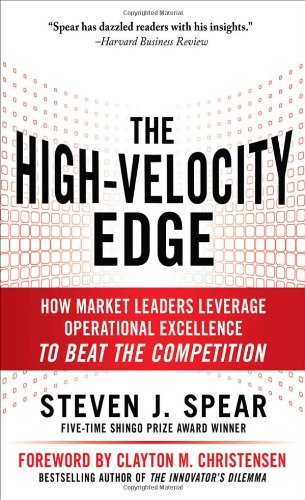
Generate Better, Faster Results― Using Less Capital and Fewer Resources! “[The High-Velocity Edge] contains ideas that form the basis for structured continuous learning and improvement in every aspect of our lives. While this book is tailored to business leaders, it should be read by high school seniors, college students, and those already in the workforce. With the broad societal application of these ideas, we can achieve levels of accomplishment not even imagined by most people.”
The Honorable Paul H. O’Neill, former CEO and Chairman, Alcoa, and Former Secretary of the Treasury “Some firms outperform competitors in many ways at once―cost, speed, innovation, service. How? Steve Spear opened my eyes to the secret of systemizing innovation: taking it from the occasional, unpredictable ‘stroke of genius’ to something you and your people do month-in, month-out to outdistance rivals.”
Scott D. Cook, founder and Chairman of the Executive Committee, Intuit, Inc.


Great explanation of a necessary core for continuous improvement,
In this book, originally titled “Chasing the Rabbit,” Steven Spear’s years of observing Toyota* and his studies of other companies, both successes and failures, have led him to distill a set of principles other organizations can use to be more successful. Spear indicates that great leaders seem to practice them instinctively, yet it is not easy for them to articulate exactly what they do. That makes it difficult for the rest of us to understand what makes them good leaders.
Spear says that simply copying what Toyota does, for example, is not going to replicate the thinking behind how Toyota manages its business. Do you have to be steeped in the culture of Toyota, as Spear was, in order to fully absorb the way it does things? That’s an option that few people have.
Spear says that it is possible to discover patterns in Toyota’s practices, to make explicit what is implicit knowledge at Toyota. When Spear and Hajime Ohba, general manager of Toyota’s Supplier Support Center happened to go on some of the same factory tours in Japan in 1995, Spear paid close attention to what Mr. Ohba did. He saw that Mr. Ohba asked the same questions on every tour, and asked them of the people working as often as of the executive guiding the tour. Whenever possible, he asked to start the tour where the end product was being shipped to customers.
What was he looking for? Pathways, connections or handoffs, and what work was being performed. Mr. Ohba was looking at process and how processes combine to form systems. That’s different from saying that the only way to learn how Mr. Ohba looked at a plant is to spend years accompanying him.
As a scientist, he observed what leaders at Toyota and at other organizations did until he could see patterns and derive a theory to explain the phenomena. From that theory, he extracts a view of complex processes and systems and an explanation for why organizations can’t make them work effectively. Then he tells us of four capabilities he found in great leaders and great organizations.
The first thing he establishes in the book is the character of complex systems. Our typical experience is that some group of people will create a system that accomplishes some goal – basically, they will think it up. It’s guaranteed that things will go wrong because no matter how much study these people do, they can’t think of everything. Then they get the blame for producing a flawed process. In turn, they blame sponsors for not including everything in their specifications, or users for not following processes as they envisioned them.
Spear says, face it, there will be unanticipated problems in any system, so have a process for identifying them and responding. In the book, he shows us how Toyota, Alcoa, and the Navy Nuclear Power Propulsion Program approach that reality successfully, and how an unnamed hospital, NASA, and others ignore flaws in their systems with tragic consequences.
His other fundamental observation of most organizations is that they are divided functionally, while processes don’t respect those boundaries. (This isn’t news to lean thinkers, of course.) People in one silo don’t know much about what happens in another or how their action may create problems for them. I spoke to Steve Spear a few weeks ago, and he offered a great illustration. In one hospital he visited, the carpeting in the administrative offices was a different color from that of the clinical departments. If you crossed the boundary, you were well aware that you were in someone else’s territory.
Spear tells readers that if you want to improve processes, you have to fully appreciate that systems are complex and problems are normal. Because they span those functional silos, problems are difficult to solve unless you can bring people from different parts of the organization together and they learn good team problem solving methods.
Actions of separate departments can be integrated, but only if leaders at a level that includes them in their scope of authority don’t sit back and leave problems to someone else. They have to own them and get involved in the problem-solving process.
Four capabilities
Spear tells us that high-velocity companies like Alcoa and Toyota accept that systems are complex so problems are normal, and, because processes cross boundaries, so must problem solving. He says these high-velocity organizations have four capabilities in common, and any organization can develop them through never-ending learning.
In a way, Spear leads the reader in probing deeper levels of each capability by giving them more complex names in successive chapters. After a first encounter with Capability One, in an introductory chapter, where it is described as “Specifying design to capture existing knowledge and build in tests to reveal problems,” it is framed much more simply as Spear begins to develop his theme. The next…
Read more
Was this review helpful to you?

|